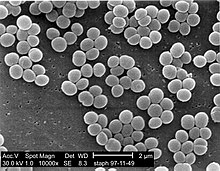
Back مكورة عنقودية Arabic مكوره عنقوديه ARZ Стафілакокі Byelorussian Стафілакок BE-X-OLD Стафилококи Bulgarian স্ট্যাফাইলোকক্কাস Bengali/Bangla Estafilococ Catalan بەکتریای ستافیلۆکۆکەس CKB Stafylokok Czech Staphylokokken German
Staphylococcus is a genus of Gram-positive bacteria in the family Staphylococcaceae from the order Bacillales. Under the microscope, they appear spherical (cocci), and form in grape-like clusters. Staphylococcus species are facultative anaerobic organisms (capable of growth both aerobically and anaerobically).
The name was coined in 1880 by Scottish surgeon and bacteriologist Alexander Ogston (1844–1929), following the pattern established five years earlier with the naming of Streptococcus.[1] It combines the prefix "staphylo-" (from Ancient Greek: σταφυλή, romanized: staphylē, lit. 'bunch of grapes'[2]), and suffixed by the New Latin: coccus, lit. 'spherical bacterium' (from Ancient Greek: κόκκος, romanized: kókkos, lit. 'grain, seed, berry'[3]).
Staphylococcus was one of the leading infections in hospitals and many strains of this bacterium have become antibiotic resistant. Despite strong attempts to get rid of them, staph bacteria stay present in hospitals, where they can infect people who are most at risk of infection.[4]
Staphylococcus includes at least 44 species. Of these, nine have two subspecies, one has three subspecies, and one has four subspecies.[5] Many species cannot cause disease and reside normally on the skin and mucous membranes of humans and other animals. Staphylococcus species have been found to be nectar-inhabiting microbes.[6] They are also a small component of the soil microbiome.[7]
- ^ "staphylococcus | Origin and meaning of staphylococcus by Online Etymology Dictionary". www.etymonline.com. Retrieved 2018-07-25.
- ^ stafulh/ in Liddell, Henry George; Scott, Robert (1940) A Greek–English Lexicon, revised and augmented throughout by Jones, Sir Henry Stuart, with the assistance of McKenzie, Roderick. Oxford: Clarendon Press. In the Perseus Digital Library, Tufts University.
- ^ ko)kkos in Liddell and Scott
- ^ "Staph infections". mayoclinic.org. Retrieved 2022-11-27.
- ^ Harris LG, Foster SJ, Richards RG (December 2002). "An introduction to Staphylococcus aureus, and techniques for identifying and quantifying S. aureus adhesins in relation to adhesion to biomaterials: review". European Cells & Materials. 4: 39–60. doi:10.22203/ecm.v004a04. PMID 14562246.
- ^ Jacquemyn H, Lenaerts M, Brys R, Willems K, Honnay O, Lievens B (2013). "Among-population variation in microbial community structure in the floral nectar of the bee-pollinated forest herb Pulmonaria officinalis L." PLOS ONE. 8 (3): e56917. Bibcode:2013PLoSO...856917J. doi:10.1371/journal.pone.0056917. PMC 3594240. PMID 23536759.
- ^ Madigan M, Martinko J, eds. (2005). Brock Biomlogy of Microorganisms (11th ed.). Prentice Hall. ISBN 978-0-13-144329-7.[page needed]
© MMXXIII Rich X Search. We shall prevail. All rights reserved. Rich X Search
